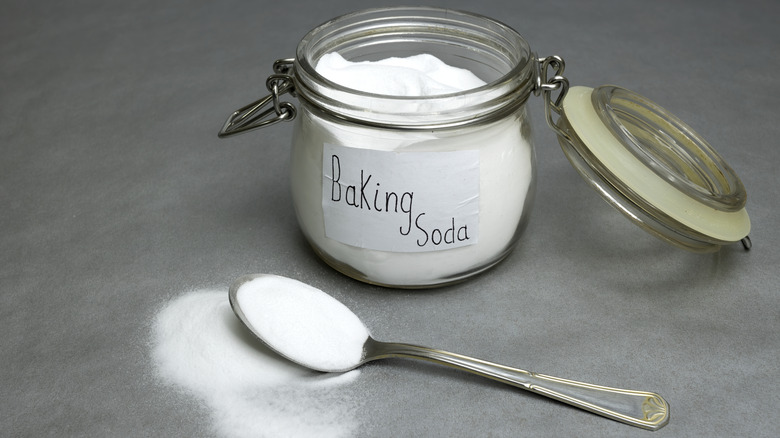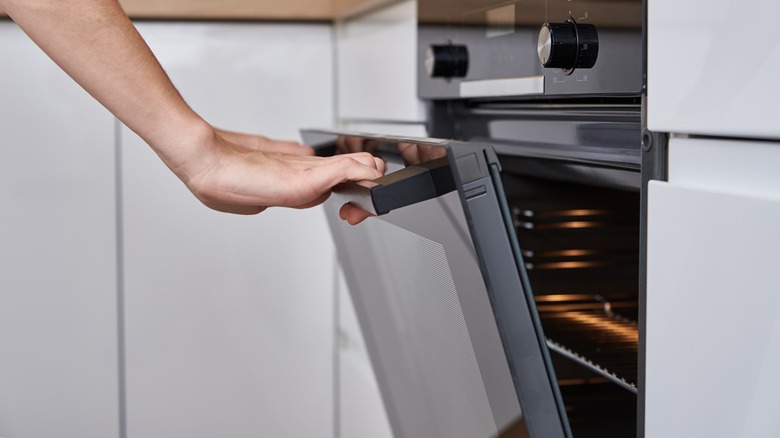What Happens When You Bake Baking Soda, And Why Is It Useful?
Baking soda is primarily used for leavening baked goods like muffins, cookies, and pancakes (as well as improving their browning ability), but if that's all you use it for, you're missing out on a world of potential. It can be used as a household cleaner, dissolved in water to make a mouthwash, placed in your refrigerator to absorb any lingering food odors, and of course, mixed with vinegar in that sweet volcano you made for the second grade science fair.
Baking soda, also known as sodium bicarbonate and bicarbonate of soda, is an incredibly versatile product, and as such, it ranks among the most commonly-used inorganic compounds in human society. But did you know that the baking soda in your pantry can also be used to create an entirely different chemical with its own unique applications? It might sound like advanced chemistry, but it's actually quite simple. All you need to do is bake that baking soda.
Heat converts baking soda into sodium carbonate
If you have an oven, you can easily turn baking soda into a different chemical called sodium carbonate. Its name is nearly the same as sodium bicarbonate, and sure enough, the compounds are closely related, but there are key differences between them that make them useful for separate purposes. To explain, we need a quick chemistry lesson (but don't worry, there won't be a final exam). The chemical formula for sodium carbonate is Na2CO3, while the formula for sodium bicarbonate is Na2HCO3. You'll notice that the difference between the two is that sodium bicarbonate contains hydrogen. This has a significant impact on the compound's pH levels.
Baking soda and sodium carbonate are both bases, but the latter is a much stronger base than the former. While sodium bicarbonate has a pH around 8.5, sodium carbonate has a pH between 11 and 12. As a reminder, the pH scale covers 0-14 with levels above seven constituting bases. This difference means that each compound has unique properties. To convert baking soda into sodium carbonate, start by heating your oven to 350 degrees Fahrenheit. Then, spread the baking soda on a baking sheet and record its weight with a kitchen scale. Pop the baking soda in the oven and stir it every half hour or so. You want to reduce it to ⅔ of its original weight, which can take around two to five hours of baking. You should reweigh the pan hourly to be sure.
Uses for sodium carbonate
Now that you know how to make sodium carbonate from baking soda, let's talk about what you can do with it. Sodium carbonate has fewer home applications than sodium bicarbonate and is mainly used in industrial settings, where it is also known as washing soda and soda ash. Most sodium carbonate is used for making glass, but it's also used in water treatment, cleaning products, and cosmetics, to name a few. There are a few ways you can use it in the kitchen as well, but before we get into that, you need to know that sodium carbonate, being a much stronger base than baking soda, is highly caustic. You should always wear gloves when you cook with it, because it can cause skin damage. If you do make skin contact, wash the area immediately. Okay, that was a bit scary we know, but here comes the fun part.
Unlike baking soda, sodium carbonate can be used as a flavoring agentand also has a profound impact on the texture and color of foods. Two of the most popular uses are in pretzels and ramen noodles. Try swapping the baking soda in a soft pretzel recipe for sodium carbonate to achieve better browning. When you're making Chinese and Japanese noodles, especially ramen noodles, the addition of sodium carbonate is essential for achieving that springy texture that is so pleasing to the tooth. It also adds bounce to bread, buns, and the mooncakes enjoyed during the Mid-Autumn Festival.


